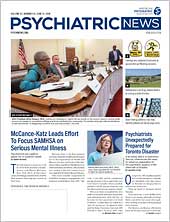Medications that interact adversely with lithium appear to be a major driver of lithium toxicity, according to a report in Psychiatric Services in Advance.
In fact, researchers found that starting a medication that interacts with lithium, such as an ACE inhibitor, antihypertensive, diuretic, or NSAID, within the past month was associated with 30-fold higher odds of experiencing lithium toxicity requiring acute care services. The study highlights an important opportunity for clinicians around patient education and empowerment when prescribing lithium.
Lauren J. Heath, Pharm.D., M.S., an outcomes research fellow in ambulatory care at Kaiser Permanente Colorado, told Psychiatric News she conducted the study because even though lithium has been used for decades, there have been many changes in how practitioners initiate, follow, and monitor patients taking the medication.
Heath and colleagues examined five years of electronic health records for 3,115 Kaiser Permanent Colorado patients who filled at least one prescription for lithium. They found that 70 patients experienced unintentional lithium toxicity during that timeframe, amounting to a prevalence of 2.2 percent. They defined toxicity as a lithium level above 1.2 milliequivalents per liter (mEq/L) or an ICD-9 code suggesting signs or symptoms of toxicity, and all cases were confirmed by independent case review.
Of those patients with lithium toxicity, 50 sought acute care services, for a prevalence of 1.6 percent. Half were hospitalized, 21 were treated at the emergency department and not hospitalized, and four were treated at an urgent care facility.
Researchers compared patients who sought acute care for lithium toxicity with those who did not experience lithium toxicity or use acute care services. They found that five patients had filled a prescription for an interacting medication within 28 days of developing toxicity. The most commonly initiated interacting medications were RAAS modulators, including the ACE inhibitor lisinopril and the antihypertensive losartan. “[T]he results reinforce the importance of efforts to immediately identify and adjust for interacting medications,” the researchers wrote.
Decision-support software at the point of prescribing and dispensing is designed to catch drug interactions before they happen. But prescribers and pharmacists constantly receive alerts, many of which aren’t useful, so alert fatigue sets in, Heath explained. “In fact, an alert fired for all potentially interacting medications identified in this study, but it was overridden by the prescriber,” the researchers wrote. Heath suggested that in addition to alerts, such systems could be modified to trigger an order for a serum lithium level between five and seven days after an interacting medication is prescribed.
So what went wrong in the other cases Heath examined? Unfortunately, many patients, especially older adults, lack appropriate knowledge about the medications they are taking, she said. For instance, several instances of lithium toxicity in the study involved patients confused about the dosage form. One patient who had been prescribed two different pill strengths had been taking 300 mg capsules instead of 150 mg capsules. Another had missed several lithium doses and attempted to “catch up” by taking several all at once.
Crystal T. Clark, M.D., an assistant professor of psychiatry and obstetrics and gynecology at Northwestern University Feinberg School of Medicine and the Asher Center for the Study and Treatment of Depressive Disorders, who reviewed the study at the request of Psychiatric News, said it highlights an important concern about using lithium in elderly patients, who often have compromised renal function and are more likely to have multiple health conditions that trigger the use of medications that can interact with lithium, such as medicines for hypertension or NSAIDs for arthritis.
Clark said patients generally don’t spontaneously wind up with a toxic serum lithium level. Rather, she usually finds dehydration or the use of NSAIDs or other interacting medications are a culprit. She counsels patients regularly on both lithium’s side effects as well as toxicity concerns, and not just when she initiates the prescription. “Over time their health status changes, and patients have to be reminded. I check in with patients regularly and ask if there are any new health concerns or any new prescriptions.”
Clark regularly reminds patients that if they are going to take an over-the-counter NSAID for headache, it can raise their lithium level and their toxicity risk.
Some clinicians have turned to other mood stabilizers out of concerns over side effects, but Clark still uses lithium regularly. “It continues to be the gold standard for bipolar disorder,” she said. “With appropriate education, assessment for risks factors, and monitoring of lithium levels, toxicity is avoidable. And appropriate monitoring can address any changes in kidney or thyroid function early.”
Clark finds that most patients respond favorably to a more conservative serum level between 0.6 to 1.0 mEq/L, which helps to minimize toxicity risks. Clark has even successfully managed pregnant and postpartum women on lithium, by doing more frequent monitoring and blood draws, as the fluid shifts in pregnancy can cause them to eliminate the drug more rapidly, she said. ■
“Risk Factors for Utilization of Acute Care Services for Lithium Toxicity” can be accessed
here.

